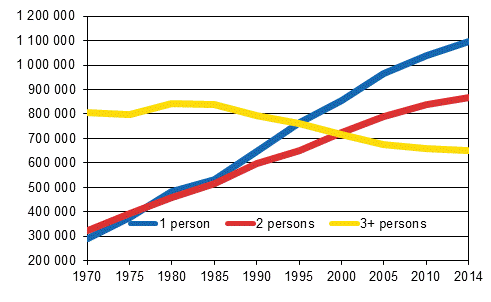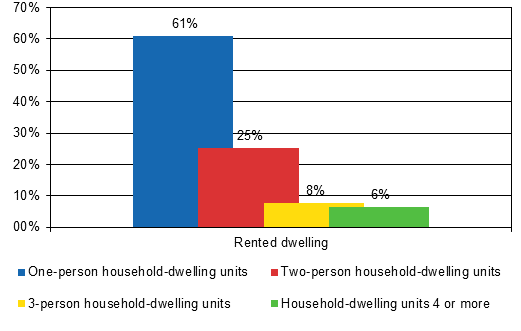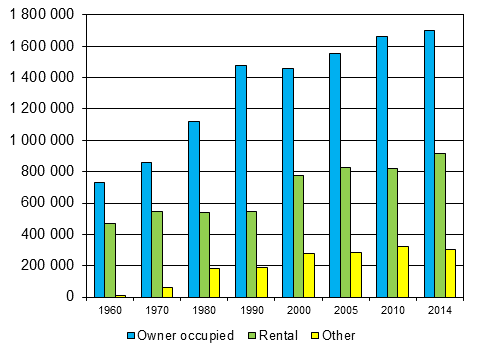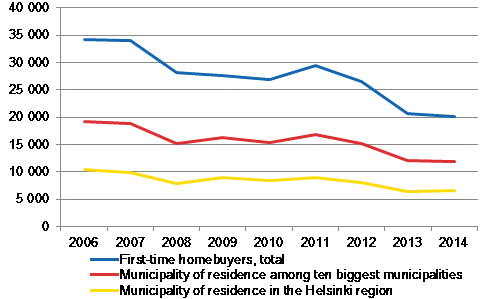2. Household-dwelling units and housing conditions 2014
Average size of a household-dwelling unit 2.04 persons
The number of household-dwelling units with one and two persons has been growing for several decades, being 75 per cent of all household-dwelling units at the end of 2014. At the end of 2014, the total number of household-dwelling units was 2,618,000, of which 1,098,000, i.e. 42 per cent, were single-person household-dwelling units. In 2014 the average size of a household dwelling unit was 2.04 persons, while in 1970 it was still three persons.
Figure 2. Number of household-dwelling units by size in 1970–2014, number

The size of a household-dwelling unit varied regionally. In urban municipalities the average size of a household-dwelling unit was 2.00 persons and in rural municipalities 2.14 persons. The structure of household-dwelling units differs between rural and urban areas. The share of one-person household-dwelling units is larger in urban areas (44%) than in rural areas (39%).
Around one half of Finns live in detached houses
Around one half of Finns live in detached houses, although only 40 per cent of permanently occupied dwellings are in detached houses. Terraced houses had 360,000 occupied dwellings, that is, 14 per cent of the dwelling stock. Of all occupied dwellings 44 per cent were in blocks of flats, although one third of the population live in blocks of flats. The explanation is that dwellings are smaller in blocks of flats, so smaller families or household-dwelling units live in them than in terraced or detached houses.Table 2. Household-dwelling units and persons by type of building in 2014
| Type of building | Household-dwelling units | % | Persons | % |
| Buildings total | 2 617 780 | 100,0 | 5 351 173 | 100 |
| Detached and semi-detached houses | 1 050 423 | 40,1 | 2 690 569 | 50,3 |
| Attached houses | 359 896 | 13,7 | 707 976 | 13,2 |
| Blocks of flats | 1 160 447 | 44,3 | 1 871 918 | 35,0 |
| Other buildings | 47 014 | 1,8 | 80 710 | 1,5 |
One household-dwelling unit had around 82 square metres of living area at its disposal, or 40 square metres per person. The floor area per person diminishes considerably as the size of the household-dwelling unit grows. The average area available for a single person living alone was 60 square metres, a two-person household-dwelling unit had 44 square metres per person but a household-dwelling unit of six persons had no more than 21 square metres of floor area per person.
Table 3. Floor area per person (m2) by size of household-dwelling unit in 1985–2014
| Year | Number of persons | |||||||
| All household-dwelling units | 1 person | 2 persons | 3 persons | 4 persons | 5 persons | 6 persons | 7+ persons | |
| 1985 | 28,9 | 48,6 | 34,3 | 27,6 | 24,1 | 21,2 | 18,7 | 15,2 |
| 1990 | 31,4 | 51,8 | 37,0 | 29,4 | 25,0 | 21,7 | 19,0 | 14,8 |
| 1995 | 33,4 | 54,0 | 39,2 | 30,4 | 25,3 | 21,9 | 19,0 | 15,0 |
| 2000 | 35,3 | 55,6 | 40,8 | 31,4 | 26,0 | 22,5 | 19,4 | 15,4 |
| 2005 | 37,5 | 57,0 | 42,4 | 32,3 | 27,3 | 23,7 | 20,4 | 16,3 |
| 2010 | 39,1 | 58,6 | 43,6 | 33,0 | 28,2 | 24,4 | 21,0 | 16,9 |
| 2014 | 39,9 | 59,6 | 44,2 | 33,4 | 28,3 | 24,6 | 21,1 | 16,8 |
One in four Finns lives in an overcrowded dwelling
At the end of 2014, the number of household-dwelling units living in overcrowded dwellings was 227,000 and the total number of persons living in such dwellings was 937,000. A household-dwelling unit is defined as living in an overcrowded dwelling if it consists of more than one person per one room of its dwelling, so a person living alone cannot be regarded as living in an overcrowded dwelling. One-person household-dwelling units excluded, 15 per cent of the rest of the household-dwelling units and almost one person in five lived in an overcrowded dwelling. The number of overcrowded household-dwelling units has decreased yearly but year 2013 the number of overcrowded household-dwelling units began to increase. In 2014 the number of overcrowded household-dwelling units has grown by around 1,000 and the number of persons living in overcrowded dwellings grown by around 4,500.
Owner-occupied dwellings have more living space than rented dwellings, when measured by floor area per person. The average floor area per persons of a household-dwelling unit living in an owner-occupied dwelling is 43 square metres, while a unit living in a rented dwelling has only 32 square metres of floor area per person.
Of rental dwellings, non-subsidised rented dwellings had the most floor area per person, 33 square metres. Differences to other rental dwellings were not large. In government-subsidised rented dwellings the floor area was 31 square metres per person. In right-of-occupancy dwellings the living space per person was 33 square metres.
Mainly household-dwelling units of one to two persons in rented dwellings
The majority of those living in rented dwellings, 86 per cent, were living alone or together with another person, while in owner-occupied dwellings the corresponding share was 70 per cent. Six per cent of the household-dwelling units living in rented dwellings and 18 per cent of those living in owner-occupied dwellings were larger household-dwelling units with at least four persons. At the end of 2014, the number of permanently occupied rented dwellings was around 824,000, of which 41 per cent were government-subsidised or interest-subsidised rented dwellings.Figure 3. Rented dwellings by size of household-dwelling unit in 2014, (%)

In all, 2,618,000 dwellings were permanently occupied at the end of 2014. Over one half of good one million permanently occupied dwellings in blocks of flats were rented dwellings. Around 116,000 dwellings were rented in terraced houses, being about one third of occupied dwellings in terraced houses. Detached and semi-detached houses had 33,000 rented dwellings.
One quarter of the population live in rented dwellings
The proportion of rented dwellings of all permanently occupied dwellings was 31 per cent, but 1.3 million, or one quarter of the population, lived in rented dwellings. The reason for this difference is that smaller household-dwelling units live in rented dwellings than in owner-occupied dwellings. At the end of 2014, the total number of permanently occupied rental dwellings was around 824,000, of which 41 per cent were government-subsidised or interest-subsidised rental dwellings. The share of government-subsidised or interest-subsidised rental dwellings of all permanently occupied rental dwellings decreased, as dwellings freed from restrictions. And that is part of the reason why other rental dwellings increased. At the end of 2014, there were 38,000 right-of-occupancy permanently occupied dwellings in Finland. Forty-four per cent of them are located in Greater Helsinki.
Figure 4. Dwellings by tenure status in 1960–2014

Renting is a tenure status preferred by young household-dwelling units in particular. As the age of the oldest person of a household-dwelling unit goes up the proportion of those living in rented dwellings goes down. In all, 75 per cent of the household-dwelling units with the oldest person aged under 30 and nearly one third of those with the oldest persons aged 30 to 44 lived in rented dwellings, while only 22 per cent of the household-dwelling units where the oldest person was aged over 45 did so. The household-dwelling units where the oldest person was aged 45 to 74 were the most likely to own their house. Forty-three per cent of the households-dwelling units meeting this age criterion were owner-occupiers of detached houses. In contrast, when the oldest person in the household-dwelling unit was older than this, owning a house was less likely. The most common mode of dwelling at a later stage in life was an owner-occupied flat in a housing company.
Number of first-time homebuyers 20,000 in 2014
According to Statistics Finland, the household-dwelling population included 20,000 first-time buyers of dwellings in housing companies. The number of first-time homebuyers has fallen by 14,000 persons (41 per cent) compared with 2006. Here, a first-time homebuyer refers to a person who has bought a dwelling in a housing company and is exempt from the asset transfer tax as a first-time homebuyer. Those having bought their first home in a real estate property are not included in the statistics.
First-time buyers of dwellings in housing companies are centred on towns. Most first-time homebuyers (60 per cent) were living in the ten biggest towns of Finland in the year of purchase. 19 per cent of first-time homebuyers were living in Helsinki.
Figure 5. First-time homebuyers by municipality of residence in 2006 to 2014, persons

In 2014, the average age of first-time buyers of a dwelling in a housing company was 28. Of first-time homebuyers, 16,000 were lived in the purchased dwelling at the end of the year. These persons were divided into 13,000 household-dwelling units, 5,100 of which were one-person household-dwelling units.
Persons aged 18 to 39 who do not already own a dwelling and who buy the dwelling for their own use are exempt from the asset transfer tax. First-time homebuyers have to move in within six months from the time of purchase, for which reason all first-time homebuyers are not living in the dwelling they own in the statistical reference period. Those registered as permanently resident at institutions, dormitories and abroad, as well as homeless people do not belong to the household-dwelling population. Helsinki region includes four towns: Helsinki, Espoo, Kauniainen and Vantaa.
The number of blocks of flats with no lift relatively high
The number of blocks of flats with more than three storeys was around 24,000, of which 3,200 had no lift. Dwellings in blocks of flats with more than three storeys and no lift numbered 103,000 and had 141,000 occupants, of whom 24,000 were aged over 65. It was even less usual to have a lift in a three-storey building. Fifteen per cent of the 349,000 dwellings in buildings with three storeys were in blocks of flats with a lift. In all, 421,000 Finns, of whom 79,000 were aged over 65, lived in three-storey buildings with no lift.
Source: Dwellings and Housing Conditions, Statistics Finland
Inquiries: Topias Pyykkönen 029 551 2628, Marja Hermiö 029 551 3211, Arja Tiihonen 029 551 3272, asuminen@stat.fi
Director in charge: Jari Tarkoma
Updated 14.10.2015
Official Statistics of Finland (OSF):
Dwellings and housing conditions [e-publication].
ISSN=1798-6761. Overview 2014,
2. Household-dwelling units and housing conditions 2014
. Helsinki: Statistics Finland [referred: 24.12.2025].
Access method: http://stat.fi/til/asas/2014/01/asas_2014_01_2015-10-14_kat_002_en.html

